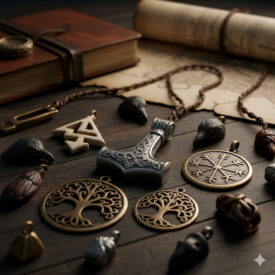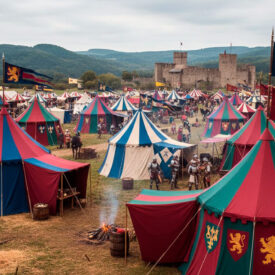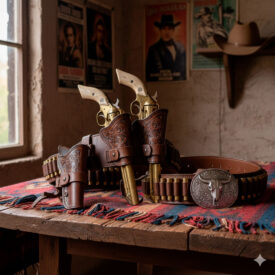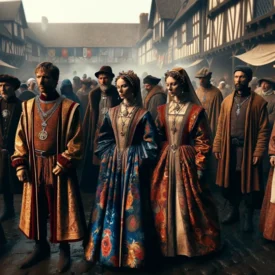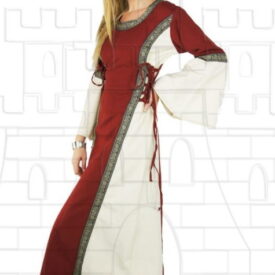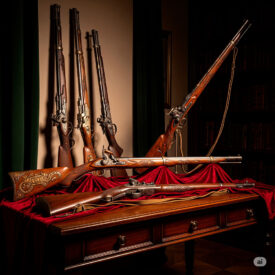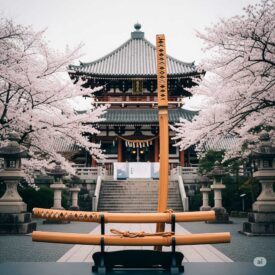Can you imagine a fur-lined cloak that rustles when you walk and recalls the wake of a Viking ship? From the frozen fjords to the souks of Córdoba, Viking and medieval furs have been more than just warmth: they are witnesses to trade, power, and craftsmanship.
In this article, you will discover how furs were used in daily life and in war, what types indicated social status, how they were processed, and what mark they left on Iberian medieval leatherwork. I will guide you through chronicles, workshops, and trade routes so that you understand why we are still fascinated by these materials today.
Furs and Leathers: Use, Trade, and Techniques from the Viking Age to the Modern Age
| Era | Event |
|---|---|
| Stone Age and Early Uses | |
| Stone Age | Animal skins were used as a byproduct of hunting; they were made more durable by smoking or applying fats to make clothing and shelters. |
| Viking Age (c. 700 – 1066 AD) | |
| c. 700 | Scandinavian populations are in a period of consolidation; furs are part of clothing and the local economy. |
| Late 8th century | Vikings wear thick woolen cloaks; clothes are made from wool, linen, and animal skins for warmth and protection. |
| After 793 | The Christian scholar Alcuin criticizes Christians who imitate Viking fashion, pointing to attention to appearance and frequent wardrobe renewal. |
| 9th Century (beginning and peak) | International trade intensifies; among the goods exchanged between the Arab world and Europe are leather and fur articles. In the warrior imagery, terms like berserker (possible derivation from “bear skin”) and ulfhednar (wolf-skinned warriors) emerge. |
| 10th Century | Beaver fur becomes a symbol of wealth for the Danish elite; exotic furs serve as visible markers of status for their warmth and non-native character. |
| 10th–11th Centuries | Vikings export furs valued for their durability and insulating capacity; furs are also used in garments (coats, cloaks, hats, gloves), tents and blankets, and as exchange goods. |
| 1002 (11th century) | The English chronicler John of Wallingford justifies acts against Danes, arguing their attractiveness and sophistication, noting their personal grooming and frequent change of wardrobe (an indicator of the use and relevance of clothing and furs). |
| High and Late Middle Ages (12th–15th centuries) — emphasis on the Iberian Peninsula | |
| Islamic period (Al-Andalus, 8th–13th centuries) | In the Tudmir cora (Murcia) and in Córdoba, oriental leatherworking techniques are developed: cordovans, split leather, and artistic leathers (guadamaciles) with modeling, engraving, embossing, and stamping. |
| 12th Century | References to women’s hose of linen or fine wool (sometimes silk); fashion shows greater refinement and eventual use of linings and fur details. |
| Late 12th – early 13th centuries | Andalusian influences on women’s fashion: garments lined internally with fur (pellizón); cloaks lined with luxurious furs such as ermine, marten, or otter. Cordovan (tanned kidskin) is valued for footwear and adorned with filigree and embossing. |
| Mid-13th century (Murcia) | Alfonso X reorganizes the city by establishing the Adobería/Blanquería outside the walls and the Rúa de la Pellejería inside, separating tanning from sales and craftsmanship. |
| 13th Century (general) | Sumptuary laws begin to limit the use of luxurious furs (ermine, otter) by Jews and Mudejars, regulating consumption according to status and religious origin. |
| 1272 (Murcia) | Alfonso X grants fiscal franchise for the export of fur and leather articles, but prohibits the exit of raw materials (furs and leathers); rabbit fur is widely used among the popular classes. |
| 14th Century | The guild system regulates tanneries, separating production and transformation and creating specialized trades: white, red, chamois leather tanners, and fur preparers. |
| 1329 (Valencia) | Documented confraternities related to leather and fur: shoemakers, furriers, parchment makers, tanners, and curriers. |
| 1339 (Murcia/Castile) | Prohibition of taking wool and sheepskins out of the kingdom if the capital is not sufficiently supplied; measures to control local supply. |
| 1351 (Castile) | Pedro I promulgates the “Ordenamiento de menestrales,” taxing prices and wages of trades such as furriers, regulating leather craftsmanship. |
| 1364 (Murcia) | The oldest artisanal regulation preserved in the region is issued to improve leather quality and prohibit shoemakers from tanning. |
| Mid-14th – late 15th centuries (Murcia) | Leather trades develop corporately: concentration of tanning in the “adoberías streets,” with the Jewish quarter maintaining a prominent and sometimes almost monopolistic role in fur work in certain localities. |
| 1456–1457 (Kingdom of Valencia) | Valencia prohibits the entry of foreign tanned leathers, affecting producers in Castellón and leading to attempts at coordination between production centers against protectionist measures. |
| 1459 (Murcia) | The trade of shoemaker is documented for the first time; shoestrings (straps) made of deer, lamb, sheep, kid, ram, and cat skins are regulated. |
| Mid-15th century | The need to import furs is documented; in Murcia, bovine and ovine leathers are bought from Galician merchants in Cartagena, reflecting internal trade networks. |
| 1481 (Murcia) | The physical isolation of the Adoberías street from the Jewish quarter is ordered, forcing the search for new tanning spaces outside the Jewish quarter. |
| 1498 (Murcia) | Furrier ordinances ratify that only those in the trade can buy raw hides and skins in the city to ensure local supply and guild control. |
| Transition to the Modern Age and Early Contemporary Period | |
| Early 16th century | The production of furs and leathers consolidates as one of the most developed activities at the beginning of the Modern Age; tanning moves in Murcia to areas near Puerta Nueva and Puerta de Las Menoretas. |
| 1805 | Cayetano Miguélez publishes “Arte de Curtir ó Instruccion General de Curtidos,” the first work in Castilian intended to describe in detail the state of the tanning sector in Spain. |
Viking Furs: Uses, Techniques, and Symbolism
In the landscapes of the north, fur was both a tool and an emblem. Vikings forged coats, cloaks, and caps that withstood the freezing wind; they also used furs as blankets and rugs inside their longhouses. For the warrior, a bear or wolf skin cloak not only provided warmth: it told a story of hunting and valor.
- Common types: sheep, reindeer, wolf, fox, and bear; beaver and marten appeared as status symbols.
- Processing: skinning, scraping, tanning with oak bark or animal fats, air drying, or smoking.
- Trade: routes linking Scandinavia with Rus’, Byzantium, and the Arab world, transforming local furs into luxurious exportable goods.
Why were some furs symbols of power?
Because rarity and origin counted as much as warmth: a beaver fur imported from the east or a black fox stole brought by exotic merchants spoke of extensive trade networks and resources to afford them. You, who seek authenticity, will recognize in each texture a map of contacts and prestige.
Furs in Medieval Leatherwork: Córdoba, Murcia, and the Trades
From tanners to curriers, the medieval production chain was complex and regulated. In Al-Andalus, in cities like Córdoba, leatherwork was elevated to an art with embossing and polychrome techniques that continue to inspire historical replicas today.
In the Iberian Peninsula, specialization led to materials with their own names: cordovan (goatskin for fine footwear), badana for soft pieces, and bovine leathers for durable soles. Guilds controlled quality and sales: the noble’s dress and the shoemaker’s were born from different hands.
Types of Furs and their Practical Uses
To guide you as a craftsman or enthusiast, here is a brief guide to the most common furs and their traditional function. This classification will help you identify why one fur is worth more than another and how to care for it.
- Bovine leathers: thick and resistant; soles and military equipment.
- Cordovans (kidskin): luxury footwear and fine leather goods.
- Badana (sheep/lambskin): linings, gloves, and delicate pieces.
- Sheepskins: coat linings, leggings.
- Rabbit and small animals: popular clothing and fillings.
Find furs and accessories in our store
If you are looking for replicas forged in tradition, our collection respects the materials and crafts that tell the story. Our items recapture the original aesthetics and techniques, adapted for modern and responsible use.
VIEW NATURAL LEATHER MEDIEVAL CLOTHING | VIEW MEDIEVAL LEATHER AND FUR ACCESSORIES
How Furs were Worked and Preserved
Traditional tanning combined patience and knowledge: cleaning, skinning, immersion in baths with barks or tanning substances, and finally, greasing. Air drying and smoking completed the process to prevent rotting and preserve flexibility.
In medieval workshops, oils and fats were used to protect leather; today we use modern alternatives but the principles remain the same: penetration, protection, and maintenance.
| Type of oil | Main characteristics | Recommended use |
|---|---|---|
| Mineral oil | High penetration, does not degrade or attract dirt | Regular protection and maintenance |
| Camellia oil | Natural, acid-free, non-volatile | Antioxidant protection, lubrication |
| Lithium grease | Dense, long-lasting, does not evaporate | Long-term storage, protection |
Social Legacy: Laws, Trades, and Restrictions
Furs not only warmed bodies; they marked hierarchies. Sumptuary laws prohibited certain classes or minorities from wearing luxurious furs like marten or ermine. Workshops were organized into guilds, and tanneries were located outside the city walls due to odor and water pollution.
This legal and social framework shaped urban landscapes, specialized trades, and trade networks that still resonate today in how we value these materials.
bags, bracelets, footwear, belts, gloves, gaiters, hats and caps, baldrics, scabbards for swords
Resolve Your Doubts about Furs in Viking Clothing and Medieval Fashion
What types of furs were most common in Viking clothing?
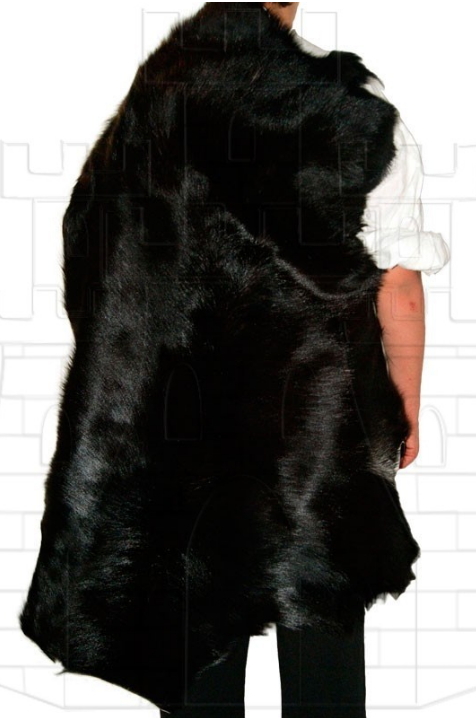 The most common types of furs in Viking clothing included sheep, reindeer, wolf, fox, and bear skins. Each had specific uses: sheep and reindeer skins for warm clothing and insulation; wolf skins for durable garments; fox skins for adornments and luxury; and bear skins for ceremonial cloaks and status symbols. In addition, some exotic furs such as beaver were also used by high-ranking Vikings to show social status. These furs were combined with leather to protect against the cold and for accessories such as shoes and belts.
The most common types of furs in Viking clothing included sheep, reindeer, wolf, fox, and bear skins. Each had specific uses: sheep and reindeer skins for warm clothing and insulation; wolf skins for durable garments; fox skins for adornments and luxury; and bear skins for ceremonial cloaks and status symbols. In addition, some exotic furs such as beaver were also used by high-ranking Vikings to show social status. These furs were combined with leather to protect against the cold and for accessories such as shoes and belts.
How did furs influence the physical appearance of Vikings?
Furs influenced the physical appearance of Vikings by providing them with visible clothing that offered warmth, protection, and also reflected their social status. The use of animal furs such as bears, wolves, or foxes created an image linked to both functionality and cultural and power symbolism, standing out in their attire and differentiating those who wore them according to their rank or wealth. Therefore, furs not only helped protect their bodies in cold climates but also influenced how they were perceived visually within their society and in other cultures.
What differences existed in the choice of furs between Vikings from northern and western Scandinavia?
There is no explicit and detailed evidence specifying differences in the choice or use of furs between Vikings from northern Scandinavia and those from the west (e.g., Norway/Sweden versus Denmark). The available information indicates that Vikings used furs from various animals — sheep, reindeer, wolf, fox, and bear — according to their thermal or resistance characteristics, rather than according to a clear geographical distinction between the northern and western regions of Scandinavia.
Furs had common practical and symbolic uses throughout Scandinavia, functioning for shelter, clothing manufacturing, blankets, and as a symbol of status. The proportion in which they were used could vary according to local availability and function, but there are no specific data on rigid differences between northern and western Vikings in the choice of furs.
Regarding physical variations such as hair color, a distinction is detected: a predominance of blond hair in the north (Stockholm, Sweden, Norway) and red hair in the west (Denmark), but this is not directly associated with differences in the use of furs.
What role did furs play in medieval fashion?
 Furs in medieval fashion played a crucial role as a symbol of status and luxury, in addition to their practical function for warmth. Fine and expensive furs such as ermine, sable marten, and fox were used to adorn noble garments, while more humble furs served to protect people of lower rank from the cold. Besides clothing, furs were also employed in accessories and as a visible social indicator in attire. Thus, furs combined thermal utility with a strong social and aesthetic value in medieval fashion.
Furs in medieval fashion played a crucial role as a symbol of status and luxury, in addition to their practical function for warmth. Fine and expensive furs such as ermine, sable marten, and fox were used to adorn noble garments, while more humble furs served to protect people of lower rank from the cold. Besides clothing, furs were also employed in accessories and as a visible social indicator in attire. Thus, furs combined thermal utility with a strong social and aesthetic value in medieval fashion.
How were furs used in medieval leatherwork?
In medieval leatherwork, furs and leathers were used essentially in both utilitarian objects and luxury items. Coarser, locally sourced furs — such as hare, deer, ox, lamb, or goat — were used to create everyday products: footwear, bags, belts, saddles, harnesses, bookbindings, knife sheaths, and even light armor pieces. Leather stood out for its strength and durability, making it an indispensable material for daily life and work.
On the other hand, finer and more exotic furs — such as marten or ermine — were imported to make accessories and adornments for noble garments, especially on collars and sleeves, thus reflecting social status. In the Late Middle Ages, cities like Córdoba became famous for the production of embossed, polychrome, and metallic leathers, intended for luxury and ornamental items.
The tanning process was fundamental: it was carried out in urban tanneries, where professionals transformed skins into leather, which was then worked by shoemakers, saddlers, and other artisans. Furthermore, in southern Spain, under Arab rule, advanced leatherworking techniques were developed, including embossing and the application of precious metals. Thus, leather was not only a practical material but also a symbol of distinction and artisanal skill.
VIEW NATURAL LEATHER MEDIEVAL CLOTHING | VIEW MEDIEVAL LEATHER AND FUR ACCESSORIES
The history of Viking and medieval furs is the story of hands that transform the wild into the useful and beautiful. If authenticity moves you, explore the pieces that keep this tradition alive: every thread, every tan, every stitch is a bridge between times.

